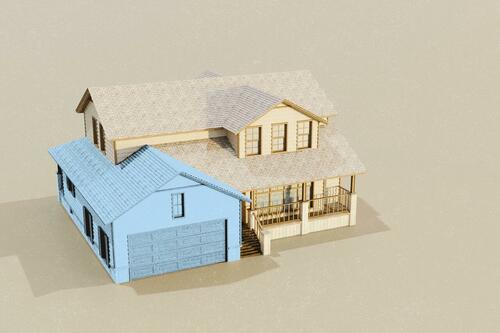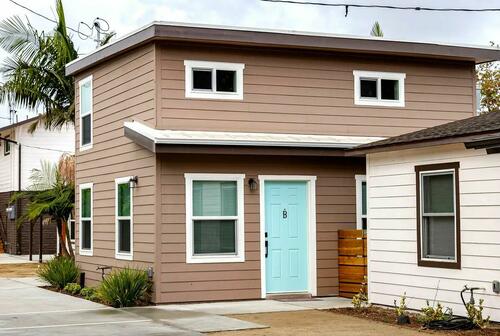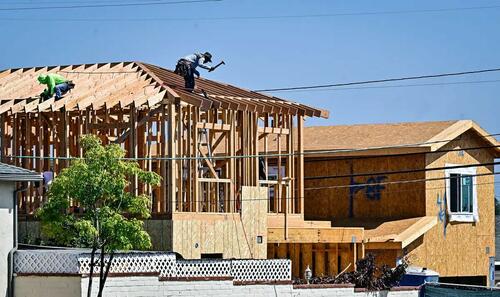Authored by Beige Luciano-Adams via The Epoch Times (emphasis ours),
For Sam Andreano, rental income from a detached accessory dwelling unit (ADU) in his backyard initially helped offset mortgage payments, and later provided a place for his son to land.
“[I] started out as just a regular homeowner,” said Andreano, a resident of Dana Point, Orange County, who began converting his detached garage into an ADU in 2019.
Researching and permitting took a few months, and total build-time was around eight months. He financed it with cash and a refinance. The entire investment, including all labor, materials, city and associated fees, came out to $165,000, and he rented the one-bedroom unit for $2,500 a month.
Now he’s working on a two-story ADU project that he intends to sell as a four-plex.
Amid soaring home prices and a housing crisis—which California leads, by some estimates, with a deficit of more than a million homes—accessory dwelling units (ADUs) now represent a significant and steadily increasing supply of overall housing construction in the Golden State.
A descendant of the post-War “granny flats” or “dowager cottages” intended to house aging relatives, at least half of contemporary ADUs are predestined for the rental market. Most are modest studios or one-bedrooms that can be built at a fraction of the cost of a traditional home, but still command market rate rents.
California issued 30,231 permits for ADUs in 2024, representing 26 percent of all new housing construction, according to statistics provided by the Department of Housing and Community Development.
While the rate of increase has fluctuated, data over the past decade show a steady year-over-year climb. After plateauing in 2019 and 2020 at under 13,000 units, the number jumped to more than 20,000 in 2021, a more than 60 percent increase.
This is largely due to a series of liberalizing state laws that have, over the past eight years, made it much easier for property owners to get projects approved in residential areas originally zoned for single-family homes.
To proponents, the boom is a bulwark against a worsening affordable housing crisis, even a corrective measure to decades of exclusionary zoning.
To critics, it overburdens infrastructure, threatens property values, degrades aesthetics, and represents an unprecedented loss of community control over residents’ quality of life.
ADUs Versus Traditional Housing
Far cheaper and easier to build than traditional housing, ADU construction has grown consistently because it is not tied to state subsidies the way larger developments are, explains Celeste Goyer, vice president of research and operations for the nonprofit Casita Coalition, which advocates for affordable housing in California.
“Even in times when the state budget is tight and the subsidies may be reduced, ADU production keeps ticking on. They kept growing during the pandemic, even when construction costs were high and interest rates were high, because ADUs use the existing land—they allow you to work with what you’ve got,” she said.
Advocates of ADU liberalization say the dwellings are part of a broader strategy to confront the state’s affordable housing crisis, which is exacerbated by high construction costs, regulatory barriers, and zoning restrictions.
“ADUs are not intended to replace traditional subsidized affordable housing for renting,” Goyer said. “There’s still a lot of multifamily housing properties being built, and that’s where deed-restricted affordable housing for rentals is being produced.”
She points to studies showing that ADUs are more affordable to low-and moderate-income tenants, typically renting for “much less—often half as much—as a standard single home.”
“Sixteen percent are rented to someone you know at low or no cost—that’s incredibly important housing,” Goyer said, calling ADUs a grassroots approach to housing family members and elders priced out of assisted living.
According to a 2021 study from the University of California, Berkeley, 51 percent of California’s new ADUs are income-generating rental units, while “very few”—15 percent—house senior citizens. Around 11 percent of new ADUs provide housing for school-aged children.
‘A Neat Little House’
At a fraction of the cost of a traditional home, unburdened by land costs, and relatively easy to approve, ADUs are attractive for both homeowners and emerging, small-scale developers.
Dennis Robinson, a resident of Anaheim, Orange County, built his first ADU in 2020, on a personal rental property.
“Then a neighbor saw what was going on,” he said. “They saw that it was just a neat little house in the backyard.”
They asked him to build one for them, which led to requests from friends and family. Within eight months, he was building full-time. So far, he’s done 60.
“Getting two ADUs, or even three, is fairly simple now across most Single Family Zoned houses,” he said.
This is thanks to SB9, enacted in 2021, which allows up to four dwellings on almost any lot zoned for a single-family residence. In 2024, SB1211 increased the number of detached ADUs allowed on lots with multi-family structures to eight.
Typically, it takes Robinson 30 to 60 days to submit a project for approval, and construction is completed within a year.
“Homeowners generally do not need to live there,” Robinson said.
But in the state’s patchwork of local ordinances, homeowners can run into other obstacles.
When Wesley Yu, a resident of East Palo Alto, sought to build a new home and a detached ADU to house extended family, the city approved splitting the lot under SB9. However, because he was building two new structures, it refused to approve the permit unless he made one an “affordable” rental, or paid a one-time fee of more than $50,000.
Yu recently sued the city in federal court, drawing on a previous Supreme Court ruling. How that case is decided, and if the issue is taken up by the highest court, could have broader impacts for the state’s many jurisdictions—more than 170, according to some counts—with inclusionary zoning ordinances.
Zoning and Density
After years of debate over zoning and density, California’s recent ADU legalizations have effectively mandated reform by overriding existing local laws, requiring cities and counties to approve projects ministerially, without a discretionary review process.
According to a 2024 California Zoning Atlas Report from U.C. Berkeley, 95.8 percent of all residential land is zoned as single-family-only, “severely constraining the spatial possibilities for denser and more affordable housing.” The average is lower when unincorporated areas are removed, around 82 percent.
The study concludes impacts are racially exclusive: Areas with more restrictive zoning have fewer non-white residents.
Areas with restrictive zoning also typically have higher land and property values, higher production costs, and lower development rates. A 2025 study from the George W. Bush Institute notes the impact on affordability: “Highly restrictive policies have outsized effects on supply and prices in the lower-tier segment of the market. This is partly because the direct effects of cost-increasing rules are larger in percentage terms when homes are relatively small and inexpensive. It’s also because overly restrictive rules undermine or reverse the filtering-down process that accounts for most housing affordable to lower-income families.”
The same study ranks the top 100 largest metro areas in the United States from the “most pro-growth” down to the “most restrictive.” Nine California cities—including San Francisco, Sacramento, and San Diego—feature in the bottom 15.
Along with other states including Oregon, California has in recent years doubled down on corrective policies meant to increase affordability, in large part by increasing density.
But eliminating single-family zoning citywide in places including Minneapolis, Portland, Oregon, and California cities, the study notes, has not produced substantial positive results.
For example, Minneapolis eliminated single-family zoning, but added only 23 “plexes” or small multi-family units in the first two years, and other trends suggested “reform allowing multifamily development in commercial areas has been far more effective than permitting complexes in formerly single-family neighborhoods.”
Portland fully eliminated single-family zoning and legalized ADUs everywhere in the city. That, plus other reforms, added only around 0.6 percent to housing stock between 2021 and 2024, according to the study.
Read the rest here…
Loading recommendations…




















